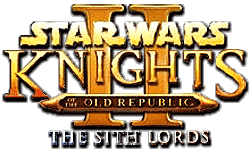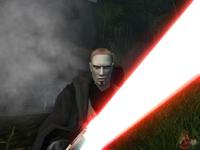|
|

|
PLATFORM
|
PC
|
BATTLE SYSTEM
|

|
INTERACTION
|

|
ORIGINALITY
|

|
STORY
|

|
MUSIC & SOUND
|

|
VISUALS
|

|
CHALLENGE
|
Adjustable
|
COMPLETION TIME
|
20-40 Hours
|
|
OVERALL

|
+ Effective use of the license
+ Even more interesting locales
+ Gripping tale
+ Useful crafting system
- Unexceptional combat
- Bugs and glitches and crashing, oh my!
|
Click here for scoring definitions
|
|
|
The enthusiastic reception of Knights of the Old Republic definitely had something to do with it, but Star Wars Knights of the Old Republic II: The Sith Lords came out quickly enough that it was doubtless already being planned. The development switched from BioWare to Obsidian, but LucasArts did an excellent job of shepherding the switchover so that the difference is hard to detect. The Sith Lords succeeds in using the Star Wars license well like its predecessor. While there are plenty of differences between the two Knights of the Old Republic games, the second adheres closely enough to the first's blueprint to make it quite strong on its own merits without seeming like a blatant copy.
In the roughly five years since the first Knights of the Old Republic concluded, the galaxy's welfare has not improved markedly. Darth Malak's defeat brought with it a number of young Jedi claiming that the teachings of their elders must have been flawed. The resultant Jedi Civil War has left the formerly numerous class completely absent from the Republic. An exiled Jedi is attempting to rejoin the flow of events after ten years of exclusion, but shadowy Sith forces have latched onto the only target they can find in order to ensure an unpleasant homecoming. The tale that follows is continually interesting, even if its conclusion seems truncated.
The Sith Lords is structured similarly to the first Knights of the Old Republic, complete with the central part of the game taking place as a search on four different planets. The events that transpire on those worlds are very much distinct from the first game, and equally engrossing to the player. Even though the planets of Dantooine, Korriban, and Telos were already visited in the first game, their structures and demographics have changed greatly, making the experience feel rewarding and not like a rehash. The cast features a few familiar faces, but the character interactions feel fresh even in the case of droids that were seen in the first game, while the many new characters are fascinating individuals to spend time with.
 It's true - having a goatee really does signify evil.
It's true - having a goatee really does signify evil.
|
|
One new aspect to The Sith Lords comes from the Influence system that governs how deeply the protagonist may interact with the other members of the cast. Both by simply engaging them in conversation and by taking actions during the course of the overall plot, the protagonist can gain and lose favor. Some characters can learn to be Jedi if they trust the protagonist enough, while others will teach useful skills only to a person they respect. Trying to gain influence with everyone is a time-consuming task, but one with plenty of rewards that are achieved through interesting conversations.
Like the first game, The Sith Lords is replete with moments in which the player can shape the protagonist's means of using the Force. Most of the time these situations offer fairly obvious Light and Dark options, such as convincing a man searching for his wife to give up and work for the nefarious smuggling exchange that keeps her penned away, or to sneak his spouse out and reunite the couple. Some scenarios are not so easy to walk away from with one clear alignment choice, and rarely will the game present just two responses to a predicament. The variety of Light and Dark side options steer the game in interesting ways, even though the core plot doesn't change drastically no matter how one plays it.
Being aligned with the Light or Dark side only matters in gameplay to Jedi, since using the Force costs much more if an ability is affiliated with the opposite end of the spectrum. That extra cost can definitely shape how a player chooses to develop Force-users, but the process of manually leveling characters is intriguing enough that doing so is not onerous. The game gives players the option to manually decide what new skills and statistics are gained with each level, and steering their progression is interesting and rewarding.
 Hey thanks, I really needed to get that kink out of my neck!
Hey thanks, I really needed to get that kink out of my neck!
|
|
The first Knights of the Old Republic featured a few pieces of equipment that could be upgraded, but The Sith Lords vastly expands this idea. The majority of armaments can have upgrades applied to them, and the player can create almost every item in the game at workbenches and lab stations scattered around the locales. Creating these items is done using components that are made from breaking down other items in the inventory, allowing the plethora of things found during the game's course to be whittled down as desired.
Combat in The Sith Lords is virtually identical to the first Knights of the Old Republic, a real time application of Dungeons & Dragons rules that automatically pauses whenever new enemies are spotted. Seeing the many battlefield participants blasting away at each other is involving, but the actual process of either letting the AI automatically take care of things or manually selecting actions is functional without being enthralling. Usually attacking the enemy and healing when necessary will get the job done, although varying the flow with more laborious strategies is always a possibility.
Continuing the standard of the first game, enemy AI in The Sith Lords is not particularly deserving of the I. Enemies will commonly take a long moment to realize that their fellows in the same room are under attack, and their remarkably poor eyesight means that altercations occurring within what ought to be their range of visibility will produce no response. The enemies also display a tendency to get easily winded, or else they might pursue the player more than a few steps before giving up. Such feeble minds are quite helpful on the occasions when enemies are ripping a party to shreds, which is possible regardless of the difficulty chosen.
The first Knights of the Old Republic was certainly not a glitch-free title, but The Sith Lords has a far greater problem, and the dozens of play testers and quality assurance personnel listed in the credits apparently didn't have enough time to smooth things over. Some of its bugs are minor inconveniences, such as getting hung up on random pieces of the landscape instead of accessing containers with items. Major ones that can force the use of an earlier save are definitely present, and the use of a FAQ to determine how to avoid them is sometimes recommended. The bugs don't make the game unplayable, but the loading screen's advisory to save often and in multiple slots is not one to take lightly.
 The fumes from this foe's mouth are fortunately impossible to replicate with current technology.
The fumes from this foe's mouth are fortunately impossible to replicate with current technology.
|
|
Mark Griskey took over the formidable duty of composing music for this game that would not sound out of place when used next to the work of John Williams, though Jeremy Soule has a credit for supplementing that work. It is to Griskey's credit that he mostly succeeds in fashioning new music that sounds right in the Star Wars universe, though most of the tracks are better at complementing the onscreen action than being a compelling listen by themselves. Ben Burtt's sound effects from the movies are reproduced precisely, so that droids, blasters, lightsabers, and all the other distinctive elements of this galaxy are heard exactly as they should be.
As for the continual voice acting, The Sith Lords upholds the high standard of its predecessor in this regard. Alien species that do not speak standard human languages sound a bit repetitive, but the words uttered in English are never less than satisfactory and are usually quite a bit more than that. Individual performances vary a bit in quality but are never a drag on the proceedings.
Some of the visuals, mostly character models, seem to have been taken from the first game without changing much. Quite a few species not seen in the first game make appearances here, such as Trandoshans, Sullustans, and Bith, while even those designs that are recycled seem to have a bit more detail. Obsidian did a good job creating the environments of the game and making them look well-realized and distinctive.
The Sith Lords definitely has issues, and its endgame shows unmistakable signs of considerable cuts made before release. The game may have been rushed to release and thus not everything it could have been, but what it offers is quite enough to remain worthwhile. It's too bad that a Knights of the Old Republic III has yet to be made, considering the opportunity to flesh out concepts introduced here that could easily stand further exploration. If the series is forever to remain a duo, though, it finished well.
Review Archives
|









